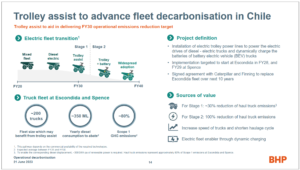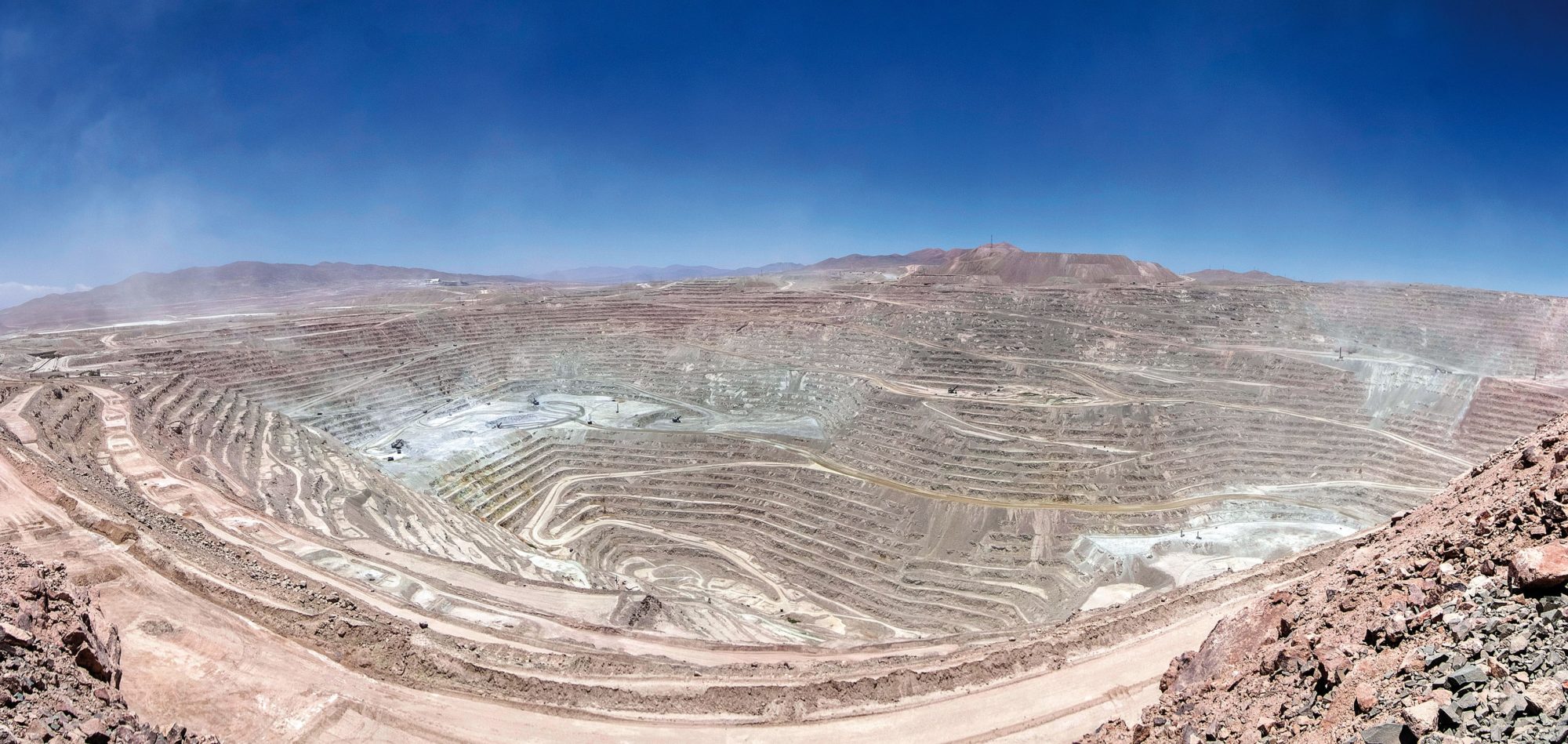In its just published operational decarbonisation investor briefing, the world’s leading mining company BHP outlined some of its plans and strategies to meet its decarbonisation targets – the most immediate of which is reducing operational emissions by at least 30% by 2030 from 2020 levels followed by net zero by 2050.
Dr Graham Winkelman, Head of Carbon Management, Sustainability & Climate Change emphasised that BHP is working hard to find the most capital efficient carbon abatement solutions adding that technology must advance quickly from where it is now, that it recognises the importance of collaborating with vendors and industry and that the pathway to net-zero will be non-linear as it grows the business.
Discussing plans for its Chile operations was Alejandro Tapia, Planning and Technical VP, Minerals Americas and soon to be Asset President at the Escondida copper mine. This is where some additional detail was given on mining fleet plans for both Escondida and Spence operations in Chile.

Tapia revealed that it has committed to trolley assist to advance fleet decarbonisation in Chile – starting with diesel trolley then advancing to battery trolley, with implementation targeted to start at Escondida in 2028 and Spence in 2029. BHP has already signed a deal with Caterpillar and Finning to replace its 160-strong fleet at Escondida with diesel-electric 372 t 798 AC Cat trucks over the next decade beginning later this year – so at this mine, these are the units that will run under trolley – no 798 AC trucks are currently running at a trolley operation elsewhere in the world though some other projects are under discussion.
At Spence, BHP has already begun deploying the competitor ultra class diesel-electric truck, the Komatsu 363 t class 980E – more are being added and are going autonomous – it has an initial target of 33 trucks in the autonomous fleet – some of which will be retrofits and some new trucks with autonomous kits. Again there are no trolley 980E trucks operating yet but there are several advanced projects.
Overall he said between the two mines the fleet that may benefit from trolley will be around 200 trucks with about 350 million litres of diesel to abate annually, which represents about 80% of those mines’ Scope 1 emissions.
Tapia states: “We will approach trolley assist in two stages. First, we will implement trolley assist with diesel-electric trucks. And second, next decade, we will expand the trolley infrastructure to assist a transition from diesel-electric to the next generation of battery electric haul trucks…we will soon begin testing diesel-electric trolley assist at Escondida, followed by Spence, with implementation of the first stage expected to start in FY28 and FY29, respectively. This timing is mostly driven by permitting, component lead times and retrofitting. Once diesel-electric trolley assist is fully deployed, we expect to reduce Scope 1 haul truck emissions by around 30%.”
He added that before it implements trolley assist, it will roll out autonomous haulage at both mines. “This made the most sense as it means we can optimise routes, battery charging cycles and avoid the costs of refitting ramps.” Of course no mines are yet running AHS on trolley but it is something both Komatsu and Caterpillar are working hard on given the high profile that trolley is taking in the Tier 1 miners’ route to net zero strategies.
Tapia adds: “We have thought deeply about the approach here in terms of timing and scale to maximise value and our plans are based on how to maximise NPV – ie we will only install trolley in ramps where it makes sense to do so for value. At the second stage, the trolley will not only power the electric drive, but it will also charge the batteries while the trucks are operating, so reducing the need to stop for static charging.” Battery trolley will phase in after 2030 – of course there will still be some static charging but trolley with its dynamic charging is very much an electric enabler as it reduces to some extent the level of headache involved in marrying charging cycles with required productivity and uptime.
He concludes: “Once the autonomous, trolley and battery electric trucks are proven, we’re planning a widespread adoption across our assets, which would enable an efficient, low-risk, zero emissions material handling solution by 2040.” So it looks like for BHP, for the next two decades, it is looking very much as a trolley-assisted future across many of its sites – initially diesel, then battery.
Later in the presentation there was also discussion by Anna Wiley, Vice President Planning & Technical, Minerals Australia on truck fleets both in the Pilbara and with the BMA coal operations. BHP’s Australian operations use roughly 1,500 million litres of diesel in over 1,000 pieces of equipment per year, of which over half is used in about 550 trucks.
Wiley continues: “Electrification is our preferred pathway to eliminate this diesel. One of the reasons for this is energy efficiency…using hydrogen as an example, we see the greatest losses at this phase due to generation, storage and transportation compared to minimal losses in electricity generation and transmission. Once on board, the fuel needs to be transferred to energy. In both todays’ diesel-electric technology, and in a hydrogen system, the fuel is used to generate electricity to drive the electric wheel motors which has additional losses compared to direct feed.”
BHP has calculated around an 80% overall efficiency from an ‘electrified’ pathway, compared with less than half of this for hydrogen. She concludes: “There would be some downside offsets to this comparable efficiency advantage from electrification, such as how we resolve long-term storage and constraints to mining operations due to power infrastructure. However, our view is that an electrified mining fleet is more economic and more achievable than the alternative fuel sources.”
For Australia, trolley was not directly mentioned with the focus being more on the battery electric trucks themselves. Being a partner with both Cat on its Early Learner program and with Komatsu as part of the GHG Alliance, BHP expects to have its first Caterpillar battery truck for trial at BHP in 2024 and will move to trial a Komatsu battery truck soon after. After completion of successful trials, it anticipates the first battery-electric truck sites being in operation from the late 2020s.











